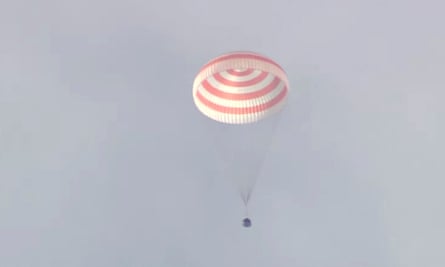A Nasa astronaut caught a Russian ride back to Earth on Wednesday after a US record 355 days at the International Space Station, returning with two cosmonauts to a world torn apart by war.
Mark Vande Hei landed in a Soyuz capsule in Kazakhstan alongside the Russian Space Agency’s Anton Shkaplerov and Pyotr Dubrov, who also spent the past year in space.
Despite escalating tensions between the US and Russia over Vladimir Putin’s war with Ukraine, Vande Hei’s return followed customary procedures. A small Nasa team of doctors and other staff was on hand for the touchdown and planned to return immediately to Houston with the 55-year-old astronaut.
Even before Russia’s invasion of Ukraine, Vande Hei said he was avoiding the subject with his two Russian crewmates. Despite getting along “fantastically … I’m not sure we really want to go there”, he said.
It was the first taste of gravity for Vande Hei and Dubrov since their Soyuz launch on 9 April last year. Shkaplerov joined them at the orbiting lab in October, escorting a Russian film crew up for a brief stay. To accommodate that visit, Vande Hei and Dubrov doubled the length of their stay.
Before departing the space station, Shkaplerov embraced his fellow astronauts as “my space brothers and space sister”.
“People have problem on Earth. On orbit … we are one crew,” Shkaplerov said in a live Nasa TV broadcast Tuesday. The space station is a symbol of “friendship and cooperation and … future of exploration of space”.
The war tensions bubbled over in other areas of space with the suspension of European satellite launches on Russian rockets and the Europe-Russia Mars rover stuck on Earth for another two years.
Just one day after Russia invaded Ukraine, Dmitry Rogozin, the director-general of Russia’s space agency, accused the US of trying to “destroy” cooperation at the ISS.
“If you block cooperation with us, then who is going to save the ISS from an uncontrolled descent from orbit and then falling onto the territory of the United States or Europe?” he said.

Nasa, however, played down the provocative comments. The agency said that it would continue to work with all its international partners – including Russia – and that export sanctions continue to allow it to work with Russia.
“That’s just Dmitry Rogozin,” Nelson told the Associated Press. “He spouts off every now and then. But at the end of the day, he’s worked with us.
“The other people that work in the Russian civilian space program, they’re professional. They don’t miss a beat with us, American astronauts and American mission control.”
The Russian invasion has resulted in canceled launches and broken contracts. Besides threatening to pull out of the space station and drop it on the US, Europe or elsewhere, Rogozin had the flags of other countries covered on a Soyuz rocket awaiting liftoff with internet satellites. The launch was called off after the customer, London-based OneWeb, refused Rogozin’s demand that the satellites not be used for military purposes and the British government halt financial backing.
Meanwhile, the European Space Agency confirmed that it was indefinitely suspending its ExoMars rover mission with Roscosmos because of the war in Ukraine.
“Despite all of that, up in space, we can have a cooperation with our Russian friends, our colleagues,” Nelson said. “The professional relationship between astronauts and cosmonauts, it hasn’t missed a beat. This is the cooperation we have going on in the civilian space program.”
By touching down in the landing zone – roughly 400km (250 miles) to the north-east of Russia’s space launch facility at the Baikonur Cosmodrome in Kazakhstan – Vande Hei surpasses Nasa’s previous record for the longest single spaceflight by 15 days.
Dubrov moved into Russia’s top five. Both are well short of the 437-day, 17-hour marathon by a cosmonaut-physician aboard the 1990s Mir space station, which remains the world record.
“Broken records mean we’re making progress,” said Nasa’s previous space endurance champ, retired astronaut Scott Kelly, whose 340-day mission ended in 2016.
Like Kelly, Vande Hei underwent medical testing during his long stay to further Nasa’s quest to get astronauts back to the moon and on to Mars. He said daily meditation helped him cope during the mission, twice as long as his first station stint four years earlier.
“I’ve had an indoor job 24/7 for almost a year so I am looking forward to being outside no matter what kind of weather,” Vande Hei said in a recent series of Nasa videos. As for food, he’s looking forward to making a cup of coffee for himself and wife Julie, and digging into guacamole and chips.
Three Russians – who arrived two weeks ago – and three Americans and one German, who arrived in November, remain on board. Their replacements are due in three weeks via SpaceX.
Next week, SpaceX will fly three rich businessmen and their ex-astronaut escort to the station for a weeklong visit arranged by the private Axiom Space.
Elon Musk’s SpaceX began transporting Nasa astronauts to the station in 2020, nine years after the shuttle program ended. For most of that decade, Russia offered the lone taxi service, with Nasa shelling out tens of millions of dollars per Soyuz seat. Vande Hei’s ride was part of a barter exchange with Houston-based Axiom.
The US and Russian space agencies are still working on a system in which a Russian would launch on a SpaceX capsule beginning this fall and an American would fly on the Soyuz, helping ensure a US and Russian station presence at all times.
